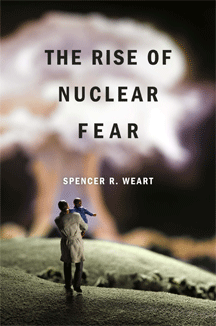By Jay Pasachoff
The historian of science Spencer Weart must have read every piece of prose and poetry ever published related to the atom, the nucleus, and the pros or cons of science to bring us this magisterial distillation. He shows how our images of nuclear energy, of terrorism, of overwhelming war, and of what Auden called The Age of Anxiety affect our reactions to important political and scientific decisions, often in conflict with reality.
So many of the images and topics he discusses have modern counterparts, so the differences between this work and his earlier book Nuclear Fear, written about 25 years ago, are significant. A prior generation may have been more worried about the giant ants that arose out of radioactivity in the movie Them! (1954). Current generations may know more about the obliteration of Los Angeles that took place in the TV cable drama 24.
The bumbling of Homer Simpson has placed a comedy value on nuclear power plants, softening their mental image for many.
The startup of the Large Hadron Collider at CERN, of recent Higgs-boson fame, did not, after all, lead to the formation of a black hole that wound up absorbing our Earth and the Universe. But Weart’s citation of an early mention by Rutherford that “some fool in a laboratory might blow up the universe” reminds us of the universality of certain themes. Dr. Johann Faust, Dr. Frankenstein, Dr. James Moriarty—all find their places in Weart’s tour through the history of potential calamity for humanity. Weart points out how people’s anxieties change over time, with the danger cited in The Day the Earth Stood Still changing from nuclear warfare in its 1951 original version to environmental damage in its 2008 update. Even Spider-Man’s original transformation from 1962 that had resulted from the bite of a radioactive spider was “realigned…in their 2002 movie, deriving his powers from a genetically modified spider.”
Weart also shows how images affect people’s views of science and scientists in general. For example, he cites how “neither Marie nor Pierre Curie,” in the 1943 movie, “could easily show human emotion.” But “in historical fact, when the real Marie’s friends took her to her husband’s corpse she kissed his cold face passionately, then clung to his body, had to be dragged from the room, and wept like any suffering human.” He takes heart in the thought that images of scientists are less negative, if more mixed, in our current age. He finds that though at least “seven significant biographical studies of Oppenheimer appeared in the years 2005-2008,” the opera Dr. Atomic by John Adams, a modern version of Doctor Faustus, was perhaps the most impressive of all the attempts to depict Oppenheimer. Still, Weart summarizes that it was “a bit too complex and enigmatic for some critics.”
Weart’s book benefits from coming out after enough time had passed so that analyses of the Fukushima nuclear-plant disaster could be referenced. “The Fukushima disaster inevitably brought a drop in public acceptance of nuclear power….Yet many environmetalists remained convinced that nuclear energy, however disagreeable, was preferable to the alternatives….The Second Nuclear Age would remain, for a while at least, an age of gradual growth in some nations and statis or retreat in others.”
Weart ends the book with “A Personal Note” of four pages. On the subject of energy, “We will not get where we want to be with one giant step, but with a thousand little ones…. A good first step would be to provide a level playing field among the various possible energy sources….The many tens of thousands of deaths…caused annually around the world by coal smoke, for example, should be paid for by the plants that emit the smoke….Should not one gram of cancer-causing substances produced from fossil fuels be sequestered as carefully as one gram produced by a nuclear reactor?”
At the end of his note, Weart writes: “The best way to affect imagery is to alter reality….Let us tell each new generation in new ways the fact that someday any town…might look like central Hiroshima in August 1945. More importantly…any town can look like the finest quarters of Paris without destroying the health of the countryside.” Weart valuably calls for a balance in our understanding of energy generation and in our plans for our nuclear energy and our nuclear waste.
Astronomer and author Jay Pasachoff is the director of Hopkins Observatory and Field Memorial Professor of Astronomy at Williams College.




